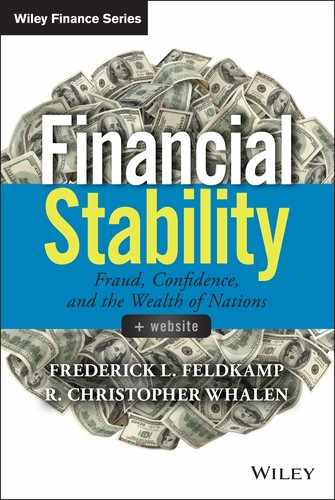CHAPTER 15
Law: Incomplete Sale ≡ Secured Borrowing
In any nation that honors the rule of law, it is the law that determines all rights and protections of debtors, creditors, and owners. By law, auditors must ignore generally accepted accounting standards when those rules result in financial statements that fail to fairly state the financial condition of an enterprise. To assure compliance, financial statements must report what an entity owns (assets) and what it owes (liabilities) in order to accurately determine its equity (net worth).
The laws of mathematics prove that the level of a financial institution’s leverage is the primary determinant of that institution’s ability to survive as market conditions change. It is axiomatic, therefore, that debt must be reported accurately.
Where in this is there room for creating an off-balance sheet liability? To state the premise is to state fraud. The very words “off-balance sheet” are themselves duplicitous.
If it’s a liability it is obviously necessary that it be reported on-balance sheet. The two concepts—off-balance sheet and liability—cannot exist together. When an asset is sold, both the upside and downside of the asset must be sold for the sale to be complete. In the 1925 opinion by Louis Brandeis, the U.S. Supreme Court ruled that any incomplete sale or pledge of any asset “imputes fraud conclusively.” Lack of completion creates ambiguity, allowing two measures of ownership—the essence of fraud.
Thus, unless dominion over the assets transferred is surrendered by a true sale or pledge, the Supreme Court decreed that receivers representing the seller or borrower, or its creditors, have an absolute right to recover at least the upside value of a sold or pledged asset from the lender or buyer. Under the UFTA, when an incomplete transfer occurs, the transferee is defined as a secured creditor for the amount paid. There is, therefore, no basis for duplicity when a sale is incomplete—it must be reported as a secured borrowing with a pledge of collateral.
It is, therefore, now settled U.S. law that any incomplete sale is a secured borrowing by the transferor. Without confirmation of a complete sale (by demonstration that no fraudulent transfer occurred and the absence of agreements restricting a full transfer of control), all financial asset transfers with continuing involvement of the seller must be reported as secured borrowings.
In a case in which an investor seeks to transfer financial assets (loans, bonds, etc.), there are two cash flows that result from either a sale or a pledge: (1) the money paid by the buyer to the seller, and (2) the money due from the underlying obligor on the asset transferred. All other factors (covenants, future recoveries, etc.) are matters of negotiation between buyer and seller or between pledgor and pledgee. External circumstances affecting the transactions are necessarily identical. All factors that determine economics for the transaction are, therefore, identical whether the transfer is a sale or a pledge.
It is only law that determines which of the two transactions (sale or secured borrowing) is accomplished. Therefore, only law decides whether parties create a loan or a sale by their transaction. According to both the U.S. Supreme Court and the UFTA, only when a true sale exists can an asset transfer be reported as a sale.
With respect to a pledge, every U.S. state has adopted Article 9 of the Uniform Commercial Code since it was first proposed in the 1950s. Under Article 9, pledges and sales of financial assets are accorded identical treatment. They both create senior rights over the transferor’s creditors when specific steps are taken to overcome the concerns Justice Brandeis expressed as conditions to proving a complete pledge. Any transaction that conforms only to the UCC can only be a true sale if and when the transaction completely transfers dominion over any rise in the net (after debt) value of a transferred asset.
A pledge, whether written as a sale or otherwise, confers only secured creditor status to the transferee, with only the right to recover the rights of a lender.
Under the USBC and the UFTA, when steps to avoid creation of a fraudulent transfer are not fulfilled, any transferee that advances sums in good faith remains entitled only to a lien for the amount advanced. When the transferee is only entitled to the value established by its purchase price plus (perhaps) interest, the transferee is a pledgee, not a buyer. Such transferees are secured parties (creditors), not buyers.
By law today, therefore, any financial asset sale that is incomplete will “impute fraud conclusively” if it is reported as a sale. Therefore the transaction is, and must be recognized as, a secured borrowing. In the appendix we provide the tests by which a true sale of financial assets is distinguished from transactions that are, by law, secured borrowings.
Law, therefore, confirms the theory of financial stability by demanding transparency and reporting of all incomplete transfers as debt, eliminating all argument that a liability may ever be reported off-balance sheet.
The concept of off-balance sheet shadow banking is, therefore, inconsistent with the law and the theory of financial stability. Absent a complete or true sale (which demonstrably complies with all requirements of fraudulent transfer law), all financial asset transfers create debt for the transferor. A transferee who in good faith pays money for an incomplete transfer is a secured creditor; otherwise the transferee is at best an unsecured creditor and often subordinate to creditors.
